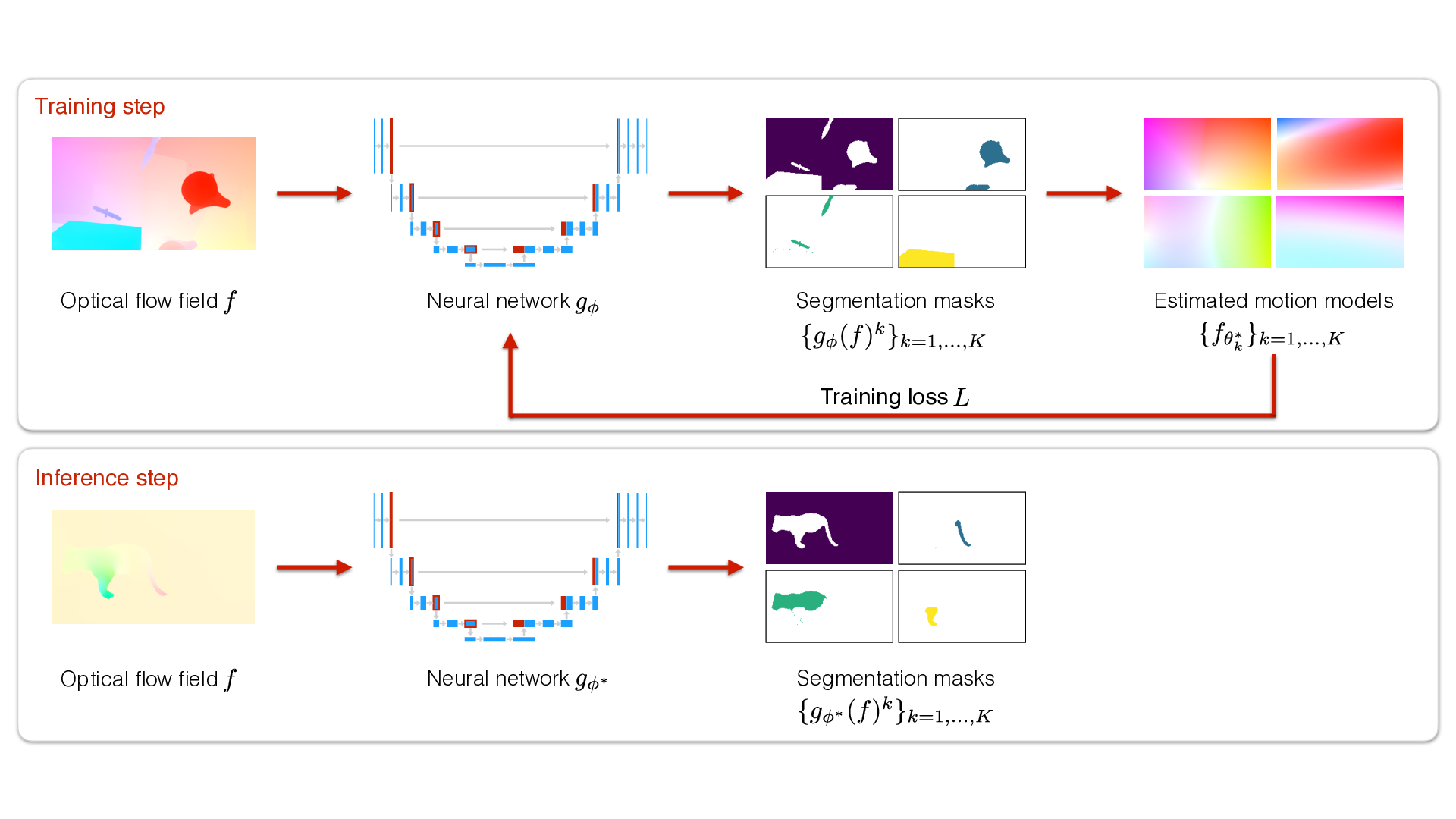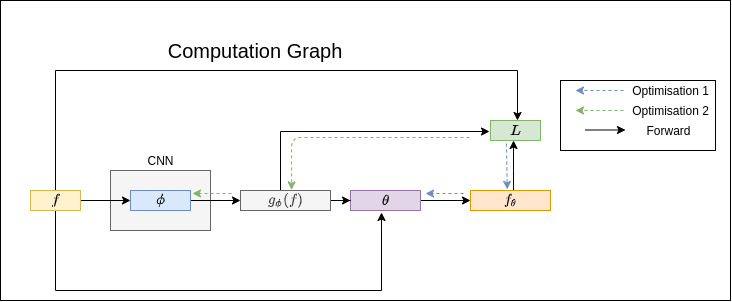[PAMI] : E. Meunier, A. Badoual and P. Bouthemy, "EM-Driven Unsupervised Learning for Efficient Motion Segmentation," in IEEE Transactions on Pattern Analysis and Machine Intelligence, 2022, doi: 10.1109/TPAMI.2022.3198480.
[Arxiv] : Etienne Meunier, Anaïs Badoual, and Patrick Bouthemy. "EM-driven unsupervised learning for efficient motion segmentation." arXiv preprint arXiv:2201.02074 (2022).
In order to use this code with your data you need to create your own "DataSplit" csv files. Those files contains the path to the files used for training / evaluation. Each row represent a sample and columns the file for each modality. You can find more information in this description.
The Datasplit used for training is given as an example as Exp6_Split.
-
Flow: path to an optical flow field (.flo). Can be computed for your dataset using [RAFT] we useraft-sintel.pth. -
GtMask: path to the binary mask for evaluation only. -
Image: RGB Frame for figures only.
Data is split into train, val and test. Train and val are used during in model_train.py, test can be used in model_eval.py.
Those split should follow the name pattern : MySuperSplit_train.csv, MySuperSplit_val.csv and MySuperSplit_test.csv.
You can train the model on your own data once your created your DataSplit.
python3 model_train.py --path_save_model /path/model_dir
--base_dir /path/dataset/
--data_file Datasplit/MySuperSplitpath_save_model: path where the model and training progression are savedbase_dir: base path for the files in the data splitdata_file: path of the DataSplits to use
If path_save_model is enabled, the checkpoint (.ckpt) of the best model - defined as the one with the lowest validation loss - is saved along with a file "results.csv" that save score and jaccard for each frame during the training.
Additional Options :
- Input Flow :
--image_size int int: choose the input / output size for the frames. Publication : 128x224.-L int: Number of output masks. Publication : 2 for evaluation.
--flow_augmentation str: use a flow augmentation adding a global motion to the input optical flow as detailled in the paper. You can useglobalmotionfor affine motion andglobalmotionfullquadfor quadratic ones along with a strenght controlling the balance between the global motion and the original one formlight,mediumandstrong. Publication :globalmotionfullquadlight.--inputs list(str): columns in DataSplit to use as input of the network. Options areFlow,ImageandFlowRGB. Inputs will be concatenated if there is several ones. Publication :Flow
- Model Structure :
--param_model str: Parametric model to use in the loss.QuadraticorAffine--v_distance str: Distance metric to use :squared,l1orl2
- Training Parameters :
- All Pytorch Lightning Parameters detailled here : [link]
- Notably
--gpus intto enable training with GPU - Logger : everything is setup to use a logger. We used [Wandb]. See [PL documentation] to setup your own.
# LOAD MODEL : First you need to download the weights on our page
from Models.CoherenceNets.MethodeB import MethodeB
ckpt = '2-Masks/checkpoint/model.ckpt'# Path of the model
model = MethodeB.load_from_checkpoint(ckpt, strict=False).eval()
# LOAD FLOW FIELD :
from csvflowdatamodule.CsvDataset import FilesLoaders
flow_path='images/00000.flo' # Example flow provided in the repo
flow = FilesLoaders().load_file(path=flow_path, type='Flow', img_size=model.hparams['img_size'])
# COMPUTE PREDICTION
with torch.no_grad() :
r = model.prediction({'Flow' :flow[None]})
plt.imshow(r['Pred'][0,1] > 0.5)A notebook "Segment a Flow" with those steps is also provided.
You can download the checkpoint of the model evaluated in the paper here (ckpt file) : [CHECKPOINT]
You can evaluate the model using the script :
python3 model_eval.py --ckpt /path/model/checkpoint.ckpt
--save_dir /path/dir/
--base_dir /path/dataset/
--data_file Datasplit/MySuperSplit
--binary_method_gen exceptbiggest
--steps val test
--draw_figs
--save_npy
--save_maskckpt: path checkpoint (.ckpt) file with model weightssave_dir: path where to save the results files. In addition to figures is saved aresults_{step}.csvfile with the score for each frame.base_dir: base path for the files in the data splitdata_file: path of the DataSplits to usebinary_method_gen: {exceptbiggest, fair} method used to select segments and generate binary masks.draw_figs: enable figure drawingsave_npy: enable saving npy file with probabilitiessave_mask: save binary mask for evaluation
Warning : The evaluation with this script is performed on frames of the size defined for the training of the model ( default : 128x224 ). Thus to perform valid evaluation on benchmark you need to resize the prediction to the size of the original Ground Truth mask. If you want to perform proper evaluation from your .npy files you can use the code in evaluationmodule.
An additional interesting point of this code is to use our loss in your own projects. As long as you have an optical flow corresponding to your image you can train the network to produce motion-coherent segments ( even if the flow is not given as input to the network).
coherence_loss(pred, flow, param_model='Quadratic', v_distance='l1') :
"""Compute coherence loss for a segment based on the given flow.
Parameters
----------
pred torch.tensor (b, L, I, J) : Mask proba predictions
flow torch.tensor (b, 2, I, J) : Optical flow map
param_model str : Parametric model used for regression ( Affine, Quadratic). Default : Quadratic
v_distance str : name of the vector distance to use for computation (l1, l2, squared). Default : l1
Returns
-------
coherence_losses (b): coherence loss for each sample of the batch
"""Example of usage :
pred = MySuperModel(image) # You design your network that takes image as input and return segmentation pred
coherence_loss = coherence_loss(pred, flow) # Using optical flow and prediction compute coherence loss
coherence_loss.mean().backward() # Coherence loss is differentiable !
MySuperModel.grad # Gradients with respect to the coherence loss to train your network.This way you can use coherence_loss to regularise your network even in collaboration with an other loss.
Download results and evaluations for the datasets here : [RESULTS]
All frames used for training and validation are listed in DataSplit/Exp6_Split_{train/val}.csv
Use Python 3.7.7 with the following requirements :
pytorch_lightning==1.2.8
pandas==0.24.1
flowiz
wandb==0.10.26
ipdb==0.13.5
torch==1.8.1
torchvision==0.9.1
seaborn


